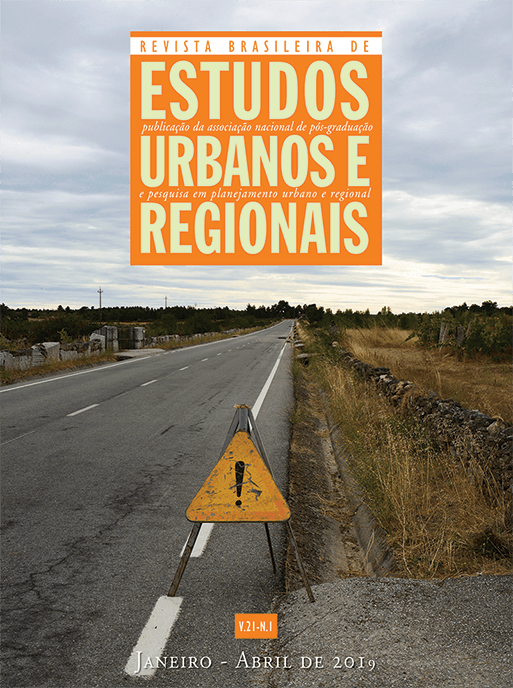Economic Integration versus Social Avoidance: Assessing Neighborhood Relationships Between the Shanty Town of Calabar and its Surrounding Upper-class Gated Communities
DOI:
https://doi.org/10.22296/2317-1529.2019v21n1p117Keywords:
Neighborhood Effect, Urban Poverty, Shanty Town, Social Segmentation, Opportunity Structures, Territorial StigmatizationAbstract
This research assesses the impact of neighborhood effects on the well-being of thirty inhabitants in Calabar, a shanty-town set within an upper-class area of Salvador (Brazil). We adopted a threefold methodological framework in order to explore the material, social and symbolic dimensions of the neighborhood effects based on a set of interviews. With regard to the material dimension, cross-class interactions via the employment nexus are fostered through geographic proximity; however social segmentation regarding access to schools, hospitals and leisure activities have reinforced the social hierarchies. In the social dimension, a high degree of cohesion and solidarity has entailed positive implications for the job search processes, access to resources and a strengthening of territorial identity. With the symbolic dimension, statistical discrimination has entailed deleterious effects on economic integration. In conclusion, the hypothesis of an opportunity-enriching environment should be subjected to careful scrutiny since the economic integration of the inhabitants neither bridges the social distances nor impedes place-based discrimination.
Downloads
References
ANDRADE, Luciana T.; SILVEIRA, Leonardo S. Efeito-território. Explorações em torno de um conceito sociológico. Civitas, v. 13, n. 2, p. 381-402. 2013.
ATKINSON, Rowland; KINTREA, Keith. Area effects: what do they mean for British housing and regeneration policy? European Journal of housing research, v. 2, n. 2, p. 147-166. 2002.
BRIGGS, Xavier de S. Brown Kids in White Suburbs: Housing Mobility and the Many Faces of Social Capital. Housing Policy Debate, v. 9, n. 1, p. 177-221. 1998.
CASTEL, Robert. Les métamorphoses de la question sociale: une chronique du salariat. Paris: Fayard, 1995
CONDER; INFORMS. Painel de informações: dados socioeconômicos do município de Salvador por bairros e prefeituras-bairro /Sistema de Informações Geográficas Urbanas do Estado da Bahia. Salvador da Bahia: Secretaria de Desenvolvimento Urbano and Sistema de Informações Geográficas Urbanas do Estado da Bahia, 2016.
GANS, Herbert. Culture and Class in the Study of Poverty: An Approach to Anti-Poverty Research. In: MOYNIHAN, David Patrick Moynihan (Org.). On Understanding Poverty: Perspectives from the Social Sciences. New York: Basic Books, 1969. p. 229-259.
GRAIF, Corina; GLADFELTER, Andrew S.; MATTHEWS, Stephan A. Urban Poverty and Neighborhood Effects on Crime: Incorporating Spatial and Network Perspectives. Sociology Compass, vol. 8/9, p 1140-1155, 2014.
HANNERZ, Ulf. Soulside: inquiries into ghetto culture and community. New York: Columbia University Press, 1969.
HÄUßERMANN, Hartmut. Armut in der Großstadt. Die Stadtstruktur verstärkt soziale Ungleichheit. Informationen zur Raumentwicklung, v. 3 and 4, p. 43-157. 2003.
KAZTMAN, Ruben. Activos y estructura de oportunidades: estudio sobre las raíces de la vulnerabilidad social en Uruguay. Montevideo: Oficina de la Cepal en Montevideo, 1999.
LEWIS, Oscar 1968. The culture of poverty.” In On Understanding Poverty: Perspectives from the Social Sciences, edited by David P. Moynihan, 187–220. New York, NY: Basic Books.
MARQUES, Eduardo C. L. Redes sociais, segregação e pobreza. São Paulo: Editora Unesp, 2010.
MASSEY, Douglas S; DENTON, Nancy. American Apartheid: Segregation and the Making of the Underclass. New York: Harvard University Press, 1993.
MURRAY, Charles. Losing ground: American Social Policy, 1950-1980. New York: Basic Books, 2015.
MUSTERD, Sako; MARCINCZAK, Szymon; VAN HAM, Maarten; TAMMARU, Tiit. Socio-Economic Segregation in European Capital Cities: Increasing Separation between Poor and Rich. Bonn: Institute for the Study of Labor, 2015.
NIESZERY, Andrea. Soziale Segregation, Quartierseffekte und Quartierspolitik. Ein deutsch-französischer Vergleich. 2013. 343 F. Tese (Doutorado em Geografia) - Mathematisch-Naturwissenschaftliche Fakultät II. Humboldt-Universität zu Berlin, Berlin
PAUGAM, Serge. Die elementaren Formen der Armut. HIS: Hamburg, 2008.
PNUD. Atlas do Desenvolvimento Humano no Brasil (accessed: January, 13 th, 2018). http://www.atlasbrasil.org.br/2013/, 2010.
RIBEIRO, Luiz C. de Q.; KOSLINSKI, Mariane C. Efeito metrópole e acesso às oportunidades educacionais. Revista Eure, v. 35, n. 106, p. 101-129. 2009.
RIBEIRO, Luiz C. de Q.; LAGO, Luciana C. A Oposição Favela-Bairro no Espaço Social do Rio de Janeiro. São Paulo em Perspectiva, v. 15, n. 1, p. 144-154. 2001.
ROBERTS, Bryan R. Globalization and Latin American Cities. International Journal of Urban and Regional Reserach, Hoboken, N.J., v. 29, n.1, p. 110-123, 2005.
SAMPSON, Robert J. Chicago and the Enduring Neighborhood Effect. Chicago: The University of Chicago Press, 2012.
SIM. Sistema de Informação Municipal de Salvador. (Accessed: : January, 13 th, 2018). http://www.sim.salvador.ba.gov.br/, 2010.
SMALL, Mario L. Villa Victoria: The Transformation of Social Capital in a Boston Barrio. Chicago: University of Chicago Press, 2004.
SMALL, Mario Luis; NEWMAN, Katherine. Urban Poverty After The Truly Disadvantaged: The Rediscovery of the Family, the Neighborhood, and Culture. Annual Review of Sociology, Palo Alto, v. 27, p. 23-45, 2001.
TELLES, Edward E. Residencial segregation by skin color in Brazil. American Sociological Review, v. 57, n. 2, p. 186-197. 1994.
TORRES, Haroldo da Gama et al. Pobreza e espaço: padrões de segregação em São Paulo. Estudos Avançados, São Paulo, v. 17, n. 47, p. 1-32, 2003.
WILSON, William J. The Truly Disadvantaged: The Inner-City, the Underclass and Public Policy. Chicago: University of Chicago Press, 1987.
Published
How to Cite
Issue
Section
Categories
License
Copyright (c) 2019 Revista Brasileira de Estudos Urbanos e Regionais

This work is licensed under a Creative Commons Attribution 4.0 International License.
Authors who publish in this journal agree to the following terms:
1) Authors who publish in RBEUR retain the rights to their work and assign to the journal the right to first publication, performed under the Creative Commons Attribution License that allows work to be shared and assures the recognition of authorship and of the original publication vehicle, to RBEUR.
2) Authors are free to assume additional contracts separately, for publication and non-exclusive distribution of the version of the work published in this journal (e.g., publishing in an institutional repository or as a book chapter), reaffirming the authorship and recognition of the original publication vehicle, to RBEUR.











.png)

